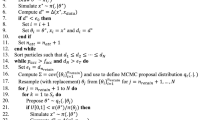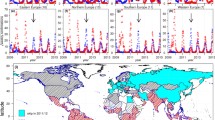Abstract
Influenza pandemics through history have shown very different patterns of incidence, morbidity and mortality. In particular, pandemics in different times and places have shown anywhere from one to three “waves” of incidence. Understanding the factors that underlie variability in temporal patterns, as well as patterns of morbidity and mortality, is important for public health planning. We use a likelihood-based approach to explore different potential explanations for the three waves of incidence and mortality seen in the 1918 influenza pandemic in London, England. Our analysis suggests that temporal variation in transmission rate provides the best proximate explanation and that the variation in transmission required to generate these three epidemic waves is within biologically plausible values.


Similar content being viewed by others
References
Akaike H (1974) A new look at the statistical model identification. IEEE Trans Automat Contr 19:716–723 doi:10.1109/TAC.1974.1100705
Anderson D, Watson R (1980) On the spread of a disease with gamma distributed latent and infectious periods. Biometrika 67:191–198
Bootsma MC, Ferguson NM (2007) The effect of public health measures on the 1918 influenza pandemic in U.S. cities. Proc Natl Acad Sci U S A 104:7588–7593
Bretó C, He D, Ionides EL King AA (2008) Time series analysis via mechanistic models. Ann Appl Stat 3:319–348
Burnham KP, Anderson DR (2002) Model selection and multimodel inference: a practical information-theoretic approach, 2nd edn. Springer, New York
Caley P, Philp DJ, McCracken K (2008) Quantifying social distancing arising from pandemic influenza. J R Soc Interface 5:631–639
Chowell G, Bettencourt LMA, Johnson N, Alonso WJ, Viboud C (2008) The 1918–1919 influenza pandemic in England and Wales: spatial patterns in transmissibility and mortality impact. Proc R Soc B 275:501–509
Day T, André J, Park A (2006) The evolutionary emergence of pandemic influenza. Proc R Soc Lond B Biol Sci 273:2945–2953
de Boor C (1978) A practical guide to splines. Springer, New York
Doucet A, de Freita N, Gordon NJ (2001) Sequential Monte Carlo methods in practice. Springer, New York
Dushoff J, Plotkin J, Levin S, Earn DJD (2004) Dynamical resonance can account for seasonality of influenza epidemics. Proc Natl Acad Sci U S A 101:16915–16916
Dushoff J, Plotkin JB, Viboud C, Earn DJD, Simonsen L (2006) Mortality due to influenza in the United States—an annualized regression approach using multiple-cause mortality data. Am J Epidemiol 163:181–187
Earn DJD, Dushoff J, Levin SA (2002) Ecology and evolution of the flu. Trends Ecol Evol 17:334–340
Eggo RM, Cauchemez S, Ferguson NM (2010) Spatial dynamics of the 1918 influenza pandemic in England, Wales and the United States. J R Soc Interface. doi:10.1098/rsif.2010.0216
Ferguson NM, Cummings DA, Cauchemez S, Fraser C, Riley S, Meeyai A, Iamsirithaworn S, Burke DS (2005) Strategies for containing an emerging influenza pandemic in Southeast Asia. Nature 437:209–214 doi:10.1038/nature04017
Gillespie DT (1976) A general method for numerically simulating the stochastic time evolution of coupled chemical reactions. J Comput Phys 22:403–434
Hatchett RJ, Mecher CE, Lipsitch M (2007) Public health interventions and epidemic intensity during the 1918 influenza pandemic. Proc Natl Acad Sci U S A 104:7582–7587
He DH, Ionides EL, King AA (2009) Plug-and-play inference for disease dynamics: measles in large and small populations as a case study. J R Soc Interface. doi:10.1098/rsif.2009.0151
Jordan EO (1927) Epidemic influenza: a survey. Chicago American Medical Association, Chicago
King AA, Ionides EL, Bretó CM, Ellner S, Kendall B (2009) POMP: statistical inference for partially observed Markov processes (R package). Available at http://pomp.r-forge.r-rproject.org
King AA, Ionides EL, Pascual M, Bouma MJ (2008) Inapparent infections and cholera dynamics. Nature 454:877–879. doi:10.1038/nature07084
Lipsitch M, Viboud C (2009) Influenza seasonality: lifting the fog. Proc Natl Acad Sci U S A 106:3645–3646
Liu R, Wu J, Zhu H (2007) Media/psychological impact on multiple outbreaks of emerging infectious diseases. Comput Math Methods Med 8:153–164
Lloyd AL (2001) Realistic distributions of infectious periods in epidemic models: changing patterns of persistence and dynamics. Theor Popul Biol 60:59–71
Markel H, Lipman HB, Navarro JA, Sloan A, Michalsen JR, Stern AM, Cetron MS (2007) Nonpharmaceutical interventions implemented by U.S. cities during the 1918–1919 influenza pandemic. JAMA 298:644–654
Miller MA, Viboud C, Balinska M, Simonsen L (2009) The signature features of influenza pandemics implications for policy. N Engl J Med 360:2595–2598
Mills CE, Robins JM, Lipsitch M (2004) Transmissibility of 1918 pandemic influenza. Nature 432:904–906
Mishra AC, Chadha MS, Choudhary ML, Potdar VA (2010) Pandemic influenza (H1N1) 2009 is associated with severe disease in India. PLoS ONE 5:e10540. doi:10.1371/journal.pone.0010540
Rios-Doria D, Chowell G (2009) Qualitative analysis of the level of cross-protection between epidemic waves of the 1918–1919 influenza pandemic. J Theor Biol 261:584–592
Ross T, Zimmer S, Burke D, Crevar C, Carter D, Stark J, Giles B, Zimmerman R, Ostroff S, Lee B (2010) Seroprevalence following the second wave of pandemic 2009 H1N1 influenza. PLoS Curr influenza, p RRN1148
Serfling RE (1963) Methods for current statistical analysis of excess pneumonia-influenza deaths. Publ Health Rep 78:494–506
Shaman J, Pitzer VE, Viboud C, Grenfell BT, Lipsitch M (2010) Absolute humidity and the seasonal onset of influenza in the continental United States. PLoS Biol 8:e1000316. doi:10.1371/journal.pbio.1000316
Taubenberger JK, Morens DM (2006) 1918 influenza: the mother of all pandemics. Emerg Infect Dis 12:15–22
Acknowledgements
We were supported by the Canadian Institutes of Health Research and the Public Health Agency of Canada. Computations were performed on SHARCNET (http://www.sharcnet.ca). The views expressed in this paper do not reflect the views of the Public Health Agency of Canada.
Author information
Authors and Affiliations
Corresponding author
Rights and permissions
About this article
Cite this article
He, D., Dushoff, J., Day, T. et al. Mechanistic modelling of the three waves of the 1918 influenza pandemic. Theor Ecol 4, 283–288 (2011). https://doi.org/10.1007/s12080-011-0123-3
Received:
Accepted:
Published:
Issue Date:
DOI: https://doi.org/10.1007/s12080-011-0123-3




